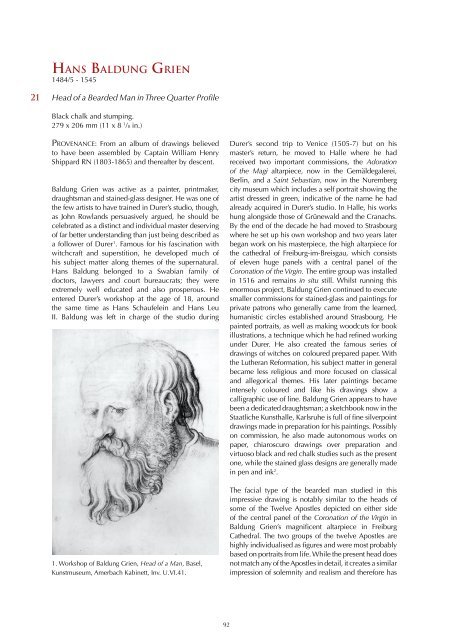Create successful ePaper yourself
Turn your PDF publications into a flip-book with our unique Google optimized e-Paper software.
Hans Baldung Grien<br />
1484/5 - 1545<br />
21<br />
Head of a Bearded Man in Three Quarter Profile<br />
Black chalk and stumping.<br />
279 x 206 mm (11 x 8 1 /8 in.)<br />
Provenance: From an album of drawings believed<br />
to have been assembled by Captain William Henry<br />
Shippard RN (1803-1865) and thereafter by descent.<br />
Baldung Grien was active as a painter, printmaker,<br />
draughtsman and stained-glass designer. He was one of<br />
the few artists to have trained in Durer’s studio, though,<br />
as John Rowlands persuasively argued, he should be<br />
celebrated as a distinct and individual master deserving<br />
of far better understanding than just being described as<br />
a follower of Durer 1 . Famous for his fascination with<br />
witchcraft and superstition, he developed much of<br />
his subject matter along themes of the supernatural.<br />
Hans Baldung belonged to a Swabian family of<br />
doctors, lawyers and court bureaucrats; they were<br />
extremely well educated and also prosperous. He<br />
entered Durer’s workshop at the age of 18, around<br />
the same time as Hans Schaufelein and Hans Leu<br />
II. Baldung was left in charge of the studio during<br />
1. Workshop of Baldung Grien, Head of a Man, Basel,<br />
Kunstmuseum, Amerbach Kabinett, Inv. U.VI.41.<br />
Durer’s second trip to Venice (1505-7) but on his<br />
master’s return, he moved to Halle where he had<br />
received two important commissions, the Adoration<br />
of the Magi altarpiece, now in the Gemäldegalerei,<br />
Berlin, and a Saint Sebastian, now in the Nuremberg<br />
city museum which includes a self portrait showing the<br />
artist dressed in green, indicative of the name he had<br />
already acquired in Durer’s studio. In Halle, his works<br />
hung alongside those of Grünewald and the Cranachs.<br />
By the end of the decade he had moved to Strasbourg<br />
where he set up his own workshop and two years later<br />
began work on his masterpiece, the high altarpiece for<br />
the cathedral of Freiburg-im-Breisgau, which consists<br />
of eleven huge panels with a central panel of the<br />
Coronation of the Virgin. The entire group was installed<br />
in 1516 and remains in situ still. Whilst running this<br />
enormous project, Baldung Grien continued to execute<br />
smaller commissions for stained-glass and paintings for<br />
private patrons who generally came from the learned,<br />
humanistic circles established around Strasbourg. He<br />
painted portraits, as well as making woodcuts for book<br />
illustrations, a technique which he had refined working<br />
under Durer. He also created the famous series of<br />
drawings of witches on coloured prepared paper. With<br />
the Lutheran Reformation, his subject matter in general<br />
became less religious and more focused on classical<br />
and allegorical themes. His later paintings became<br />
intensely coloured and like his drawings show a<br />
calligraphic use of line. Baldung Grien appears to have<br />
been a dedicated draughtsman; a sketchbook now in the<br />
Staatliche Kunsthalle, Karlsruhe is full of fine silverpoint<br />
drawings made in preparation for his paintings. Possibly<br />
on commission, he also made autonomous works on<br />
paper, chiaroscuro drawings over preparation and<br />
virtuoso black and red chalk studies such as the present<br />
one, while the stained glass designs are generally made<br />
in pen and ink 2 .<br />
The facial type of the bearded man studied in this<br />
impressive drawing is notably similar to the heads of<br />
some of the Twelve Apostles depicted on either side<br />
of the central panel of the Coronation of the Virgin in<br />
Baldung Grien’s magnificent altarpiece in Freiburg<br />
Cathedral. The two groups of the twelve Apostles are<br />
highly individualised as figures and were most probably<br />
based on portraits from life. While the present head does<br />
not match any of the Apostles in detail, it creates a similar<br />
impression of solemnity and realism and therefore has<br />
92
















